Introduction
Most raw materials for plants that process woody biomass are delivered in bulk trucks and some are delivered by railcar. This article concerns biomass delivery by truck and the systems available for unloading the trucks.
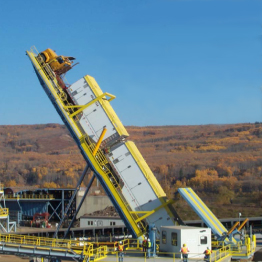
Residual chips, shavings, and sawdust from sawmills are delivered primarily by truck to pulpmills, pellet plants, and panelboard plants. Woodwaste (hog fuel) from sawmills and other raw log processors is delivered by truck to biomass-fired energy systems and cogeneration plants. Wood pellets are delivered by truck and by railcar and are loaded onto ships or delivered direct to biomass-fired power plants.
Delivery by Truck
There are many different types and sizes of trucks used depending upon the material being handled, the weather conditions, the unloading facilities available, distances traveled, the types of truck available, road conditions, the most economical transport method, road weight allowances, required throughput capacity, etc. There are generally two types of trucks used: self unloading and non-self unloading trucks.
Self-unloading Trucks
Self-unloading trailers are available in the following configurations:
- End-tipping trailer boxes or conventional end-dump trucks in many sizes.
- Live-bottom `shuffle-floors’ in 53’ (16.2m) trailers.
- Live-bottom, chain or belt conveyors in 40’ – 53’ (12.2m – 16.2m) semi trailers.
- Roll-on, Roll-off boxes.
- Side-tipping trailer boxes; some in B-train trailers.

Self-unloading trucks and trailers can dump their loads onto a paved pad or directly into a receiving hopper. Live-bottom trailers take 15-20 minutes to discharge their loads.
Wood pellets are free-flowing but are delicate and must be protected from weather. In addition to the trailers described above, wood pellets can be delivered readily in bottom discharge trailers (belly dumps) or in trailer boxes with live-bottom screw conveyors. Belly dump trailers discharge into in-ground hoppers, which are subject to contamination from the truck driving over, particularly in cold climates where snow, ice, sand and rocks stick to the underside of the trucks.
Some companies utilize self-unloading trucks with pneumatic conveyors for unloading wood pellets; however, this method is slow and is not recommended as product degradation is quite high.
Non-self Unloading Trucks
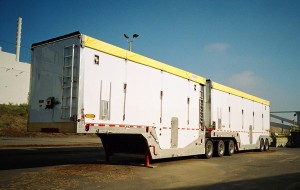
In Canada, wood chips for pulpmills are typically delivered in 8-axle, Super B-train trucks with `lead’ and `pup’ trailers with `possum-bellies’ delivering up to 6,000 ft³ (170m³) of payload. Depending upon the jurisdiction, these trucks can be 90’ (27.4m) long and longer. In British Columbia (BC) and Alberta (AB), large capacity extended Super B-train trucks are being used to transport light chips made from Mountain Pine Beetle (MPB) killed wood. These very large trucks are more economical to operate particularly on long haul distances >150 km.
Conventional chip trailers are emptied through their end-doors on end-tippers / dumpers. On smaller dumpers, the trailers have to be disconnected from the truck and emptied separately, but on the largest dumpers these trailers can be emptied without decoupling. As the truck and trailers are tipped, the pup trailer empties first, then the chips from the lead trailer slide through the pup trailer into the receiving hopper.
Wood chips, shavings, sawdust and pellets are often delivered in semi-trailers designed for the service transporting up to 3,400 ft³ (96m³). These can be self-unloading or can be emptied on an end-tipper.
Trucks that are emptied on an end or side-tipper must have the engines and tanks properly configured to prevent leaking or flooding at extreme tilt angles.
Truck Dumpers
Truck dumpers come in many sizes and configurations. There are two basic types: end tippers and side tippers.
End Tippers
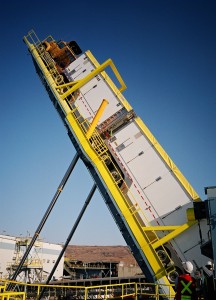
End tippers are the most common truck dumper and have a platform that lifts the front of the truck or trailer so that the material slides out of the back of the truck or trailer. Common features on an end-tipper include: a dumper deck with hydraulic lift cylinders, pivot bearings at the discharge end, a backstop, safety hold-down hoops, vibrators, a hydraulic power unit, hydraulic piping and a live-bottom receiving hopper.
Dumper decks
Dumper decks can be as short as 45’ (13.7m) long for short trucks and trailers and up to 90’ (27.4m) long for extended Super B-Train truck / trailer combinations. Truck-trailer combinations longer than the dumper deck can be handled at mills with short dumpers, but it means that each trailer must be decoupled from the train and dumped separately, greatly increasing the truck turn-around time.
The hydraulic tipping cylinders lift the deck and truck to a maximum of 65° from horizontal. The deck should be designed to resist permanent deformation should one dump cylinder fail while the deck is in the up position with a fully loaded truck.
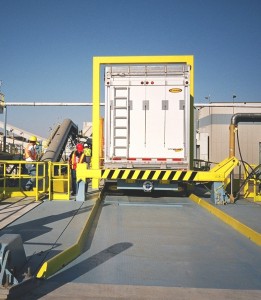
The dumper deck is equipped with a backstop against which the back-end of the trailer butts up against to prevent it from sliding off the back of the dumper, and also with safety hold-down hoops to keep the truck trailer from lifting up off the dumper when in the raised position.
Hydraulic Components
The main hydraulic lift cylinders are large, multi-stage cylinders, up to 19” (483mm) diameter and up to 600” (15.2m) stroke. Multi-stage cylinders can be mounted with the cylinder rod down or up, but mounting the rod down prevents dirt and contaminants from accumulating on the top of the rod segments thereby minimizing rod and barrel wear.
Dumpers require large hydraulic systems to operate the main lift cylinders quickly, and if installed, a backstop cylinder, vibrator[s], bridge cylinders and receiving live-bottom hopper hydraulic drive motor. The hydraulic system should have the following components: large tank with flooded-suction pumps, manifold mounted valves, filters on pressure and return lines, proportional valves for controlling the speed of the main cylinders as they extend, retract and pass through the multi-stage cylinder transition zones.
The hydraulic piping system should utilize heavy wall piping with SAE 4-bolt flanges designed for the service. Piping can be carbon or stainless steel but should be pickled and passivated. In cold climates, the piping should be insulated and have valving installed to permit warm oil to recirculate to all the components when the dumper is not in use, thereby keeping the components warm and ready for use.
The hydraulic system should be equipped with a safety circuit that prevents the deck from automatically dropping should one cylinder or the hydraulic lift circuit fail.
Back-on and Drive-through End Tippers
There are two main types of end-tipper; back-on and drive-through. As the `back-on’ name implies, the truck / trailer backs onto the dumper deck from the non-pivot end and drives forward off the same end of the deck. In a drive-through dumper, the truck drives onto the deck from the pivot end and exits from the other. The big differences between the two types of dumpers are the increased complexity and the higher truck through-put rate on the drive-through dumper.
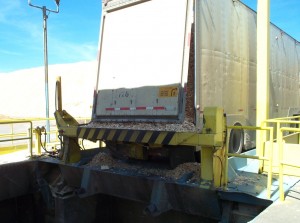
The drive-through dumper has a drive-over bridge that permits the truck to drive over the receiving hopper and onto the dumper deck. The drive-over bridge is equipped with hydraulic cylinders to lift it up out of the way, exposing the receiving hopper before the dumper deck is lifted and the chips start to fall out of the trailers.
On a back-on dumper, the deck backstop is permanently fixed in the up position. On drive-through dumpers, the backstops can be either retracted into the deck or pivoted up to one side to permit the entering truck to pass by. In cold climates, the backstop is equipped with one or more hydraulic or electric vibrators, which are used to shake the truck trailer once it is in the up position, in order to loosen chips which might be frozen to the bottom or sides of the trailers.
At-Grade and Above-Grade Dumpers
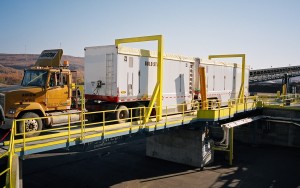
Dumper decks can be located at-grade or elevated above grade. Dumpers located at grade require a deep below-grade pit >30’ deep (9.1m) to house the large receiving hopper, which is usually sized to hold 1.5 truckloads of material. Elevating the material out of a deep pit requires a long belt conveyor. Below-grade pits can often be a problem in areas with high water-tables.
Drive-through dumpers are often located 10’ – 20’ (3m-6m) above grade, the intent being to minimize the depth of the below-grade receiving pit. Above-grade, drive-through dumpers require long ramps at each end of the dumper, gently sloped for the trucks to drive on and off the dumper; this can result in a very large footprint for the drive-through dumper system. For example, a 10’ (3m) high ramp at 5% slope is 200’ (60m) long. So, the total footprint size for an above-ground dumper installation including ramps and truck turning circle can be between 60’-80’ wide by 500’-600’ long (18m-24m by 152m-183m).
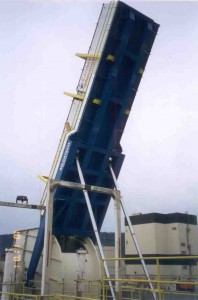
Back-on dumpers are available in an extended-arm configuration that permits the receiving hopper to be mounted above-grade or slightly below grade. Extended arm dumpers lift the truck above the above-grade hopper, so are limited to 80’ (24.3m) long decks.
Cycle Times and Throughput Rates
Recommended cycle times for end-tippers are, deck up – 1 minute and 55 seconds, and deck down – 1 minute and 30 seconds.
Dumper throughput rates depend upon: the truck staging time, the dumper cycle time, the receiving hopper run-out time, and the truck exit time. Typical throughput rates for drive-through dumpers are 5 trucks per hour average and 6 trucks per hour maximum.
Fast cycle rates are important to reduce the time the trucks are on the millsite, thereby reducing demurrage charges. Some large pulp and paper mills have multiple dumpers processing up to 250 Super B-train trucks per day, so demurrage charges can be significant if trucks are delayed.
Typical throughput rates for back-on dumpers are quite a bit less, 3-4 trucks per hour average on the large dumpers. However, if the deck is too short to handle coupled dual trailers, then each trailer must be uncoupled and dumped separately, which greatly increases the truck cycle time to a maximum of 3 trailers per hour.
Dumper Structures
Dumpers require heavy foundations to resist the truck and chip dead loads, the shifting pivot loads, the shifting hydraulic cylinder loads, the wind loads and the dynamic loads from chip payloads falling 60’ (18.3m) from a truck into a receiving hopper. The concrete pits required to hold a receiving hopper are deep and large. The tunnel required for the belt conveyor from the receiving hopper is large and long.
As noted, above-grade dumpers need long in and out ramps. And, unless the dumper is situated in an open field, retaining walls are often required to keep the ramps from impinging on adjacent buildings or structures.
Control booths are required. A control booth, with typical dimensions of 6’ x 8’ x 8’ (1.8 x 1.8 x 2.4m), should be equipped with large windows, anti-slip flooring, HVAC, control panel, good lighting, intercom with the mill control room and a card reader.
The dumper hydraulic power unit (HPU) should be located inside an enclosure to protect it from the weather, particularly in cold climates. The enclosure should have filtered make-up air to prevent wood dust from accumulating on the HPU.
Control Devices
Back-on dumpers should be equipped with the following minimum control devices:
- Deck upper and lower limit switches.
- Deck position indication (Temposonic cylinder), to control deck speed at the cylinder transition points.
- Truck location photocells.
- Wind-speed sensor.
Drive-through dumpers have the additional control devices:
- Bridge upper and lower limit switches.
- Backstop upper and lower limit switches.
- Backstop safety pin position switch.
As a minimum, the hydraulic power unit (HPU) should have:
- High and low oil pressure switches.
- Oil temperature sensors and switches.
- High and low oil level switches.
- Air/oil cooler and oil heater.
Description of Typical Dumper Operation
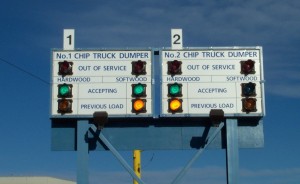
Trucks enter the millsite and typically drive onto a truck weighscale where the trucks are weighed and other pertinent information is recorded, including: trucking company, truck #, source and type of product, species, weight, etc. This information is often recorded on printed bar code cards. After weighing-in, the truck drives off the weighscale and drives to the truck staging area located before the truck dumper.
A set of traffic lights is often used to control the truck traffic to the dumper. When the dumper is available, the traffic light turns to green to signal that the next truck can drive onto the dumper.
Drive-Through Dumper Operation
Following is a description of a typical dumping sequence for a drive-through dumper. Most dumpers are operated by the truck driver. When the traffic light turns green, the driver drives the truck over the drive-over bridge and onto the dumper deck. As the truck enters the dumper, a photocell turns the traffic light to red.
At a local control station, the driver operates controls to position the backstop, before backing the truck up against the backstop. The driver then engages the truck brakes, dumps the air from the air suspension system and stops the truck engine. After leaving the truck cab, the driver opens the trailer doors, engages a safety pin in the backstop and places a collecting bucket under the chip sample spout, if he is required to take a sample. He then enters the control booth where he scans his truck information card in a card-reader before starting the dump sequence.
The operating system’s programmable logic controller (PLC) should be programmed such that the dumping sequence cannot be started until the truck information has been scanned, the receiving hopper is empty of the previous truck load and the backstop pin is engaged. Upon receiving approval from the PLC to start the dump sequence, the driver presses and holds a `Dump’ button, and the drive-over bridge rises up.
Once the bridge is up, the dumper deck will start to rise up. The driver must hold the dump button continuously or the dumping sequence will stop and the bridge and deck will hold in position. The purpose for this is to ensure the driver is safely inside the control booth whenever the dumper is in operation.
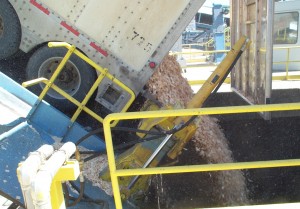
As the deck rises, the material load in the pup trailer pushes the back doors open (at ~35° – 40° deck slope) and the chips start to slide out of the trailer and into the receiving hopper. When the pup trailer is empty, the material load in the lead trailer pushes against and opens the lift panel on the front of the pup trailer and the chips slide out of the lead trailer and through the pup trailer and into the receiving hopper. Total trailer emptying time is approximately 1 minute.
Chip samples should be taken by an automatic chip sampler while the truck is dumping and the live-bottom hopper is metering the chips into the conveyor system.
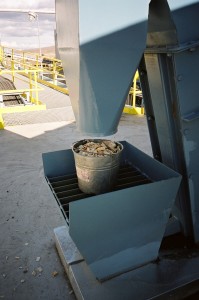
When the dumper deck is all the way up, the driver will be able to operate the backstop vibrators to loosen frozen chips, if required. The PLC should be programmed to control the timing and limit the amount the vibrators can be used. The PLC must also be programmed to not allow the operator to rapidly jog the dumper `up’ and `down’ in an effort to shake loose stuck chips, as this can cause the truck to bounce on the inclined deck and possibly jump over the backstop and fall into the receiving hopper.
When the trailers are empty, the driver releases the Dump button and presses a `Down’ button and the dumper deck will start to lower back down onto its supports. When the dumper deck is all the way down, the drive-over bridge will lower back into place. If the driver releases the Down button the deck and bridge will stop and hold in position.
When the deck and bridge are back down on their stops, the driver leaves the control booth, removes the backstop safety pin, transfers his chip sample from the collection bucket into a sample bag and attaches his truck information. He then enters his truck, starts the engine, engages the air suspension, releases the brakes, drives forward off the dumper deck, stops and closes his trailer doors. As the trailer pulls off the dumper deck, a photocell automatically moves the backstop out of the way ready for the next truck and turns the traffic light to green.
The driver of the empty truck drives back to the truck scales, weighs out and leaves the site. Some dumper decks have an integral truck scale built into the dumper deck, which helps to reduce the truck turn-around times.
Back-On Dumper Operation
The sequence is much the same as for a drive-through dumper with the following exceptions:
- There is no drive-over bridge so the trucks are backed onto the dumper and driven off from the same end.
- The backstop is fixed in place, so the driver doesn’t have to be concerned with the backstop operation.
Portable and Transportable Trailer Dumpers
Portable and transportable trailer dumpers with short decks are available and are generally used in temporary circumstances for dumping small trucks or separated trailers. Portable dumpers are equipped with truck axles and wheels and can be towed from location to location. Transportable dumpers are hauled to location on flat-bed trucks.
The dumpers are equipped with outriggers on each side to minimize the risk of the dumper toppling sideways.
Portable / transportable dumpers are often located on top of an earthen ramp contained by a retaining wall, over which they dump the trailer loads onto a paved pad. A front-end loader then pushes the chips away before a second trailer can be emptied. A strong concrete pad is recommended for sitting the portable / transportable dumper on. With all the decoupling and recoupling required, the maximum throughput rate for a portable / transportable dumper is 3 trailers per hour.
Side Tippers
The quality of residual wastewood (hog fuel) can vary considerably from loose sawdust to dry, curled bark, to green, ropy bark, and often is very difficult to handle. Material transport over long distances is most economical if large capacity Super B-Train truck / trailer combinations are used but these trailers loaded with hog fuel are difficult to handle on a conventional end-tipper.
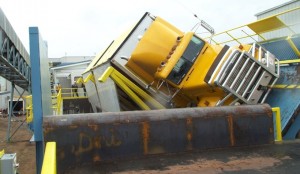
Side-tipping dumpers have a platform that tips the trucks to one side. Side-tippers are not common; the author knows of only one in existence that is used for emptying trailers filled with processed hog fuel in an extreme northern climate. This hog fuel dumper (HFTD) was developed because hog fuel tends to be wetter than wood chips and freezes inside conventional trailers on long haul distances and is difficult to empty out of conventional end-discharge chip / biomass trailers, particularly coupled B-Trains. In cold weather on a conventional end-tipper, it is necessary to decouple the trailers and empty them separately, which is a time consuming and not always effective practice. Once biomass has frozen inside a trailer, the only solutions are to accept the payload loss or park the trailer indoors and let it thaw out.

Side-tipping dumpers require special trailers that have one side that opens. The open area is 4-5 times as great as that on a conventional end-discharge trailer. When the trailers are tipped to the side, the hog fuel mass is not restrained and falls quite easily out of the large open area.
Side-tippers have the following features and accessories:
- Drive-through style.
- Deck long enough so that decoupling is not required.
- Deck tips to one side by hydraulic cylinders.
- Truck hold-down chains are required because the load passes the center of gravity (CG) when tipped.
- A hydraulic power unit (HPU).
- A very long, above-grade receiving hopper, to match the overall trailer discharge length.
- Approach and exit ramps.
Maximum throughput on a side-tipper is approximately 4 Super B-Trains per hour depending upon the ability of the downstream conveying equipment to handle the variable quality of the hog fuel.
Side-tipping, Self-unloading Trailer Boxes
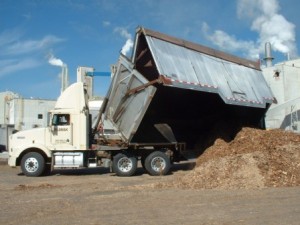
Side-tipping, self-unloading trailers deserve to be discussed in more detail here. These trailers have been used successfully for hauling processed wastewood (hog fuel) in northern British Columbia (BC), Canada, which experiences very cold winters where hog fuel tends to freeze inside the trailer boxes on long hauls. These side-tipping trailer boxes have sides that open full-length, similar to those side-opening trailers used on the side-tipping dumper platform, with one significant difference; they don’t need a trailer tipper / dumper to empty. Rather than tipping the entire trailer, the boxes tip sideways on an integral heavy steel trailer frame.
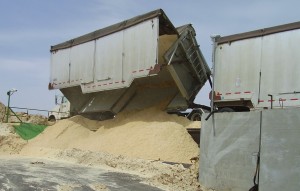
As with the side-tipping dumper platform, the side-tipping trailers go past the center of gravity when tipping. In order to prevent the trailer from capsizing sideways, it is necessary to drive the entire coupled truck / trailer unit slowly in a tight arc as first one then the other trailer is tipped and emptied. In this manner, the truck / trailer arc prevents the over-center trailer from capsizing. Unfortunately, this dumping method spreads the material over a considerable area, which must then be cleaned-up by a front-end loader.
If dumping into a receiving hopper, the stationary, side-tipping trailers must be chained-down before tipping the trailer boxes.
One of the big disadvantages of the side-tipping trailers is that the heavy steel trailer frame reduces the allowable payload significantly, which is a concern over long haul distances.
Safety
In addition to the common safety procedures in place in all wood processing plants, there are a few practices that are particular to the operation of a biomass truck dumper.
- No one should be on or under the dumper deck or bridge when the dumper is in operation.
- Do not operate the dumper above the manufacturer’s recommended wind speed, usually 40 mph (64kph).
- Clean snow and debris off the dumper deck before operating.
- Do not rapidly jog the dumper deck `up’ and `down’ in an attempt to shake loose stuck chips.
- Do not overfill the receiving hopper.
- Ensure that stationary side-tipping trucks are properly restrained by chain `hold-downs’ to prevent them from capsizing when the load goes over-center.
Receiving Hoppers and Outstocking System
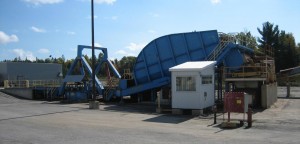
Live-bottom receiving hoppers are most commonly multi-strand, drag-chain conveyors, but `shuffle-floor’ (walking-floor) hoppers are sometimes used. The receiving hopper should be large enough to contain approximately 1 ½ truckloads. If the outstocking system is properly designed, the receiving hopper should be empty and ready to receive the next truckload by the time the next full truck is on the dumper deck and ready to dump. The live-bottom hopper should have a fixed discharge opening and a variable speed drive for accurately metering the chips onto the outstocking conveyor.
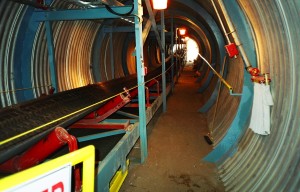
Belt conveyors are most commonly used to convey the chips from the receiving hopper to the storage area, but must be properly designed for the operating conditions. The minimum recommended belt size for a large truck dumper is 48” wide (1219mm) operating at 450 fpm (2.29mps). The belt conveyor should be equipped with a belt weighscale for measuring the material throughput. It is recommended that a self-cleaning magnet be installed over the conveyor discharge pulley for removing tramp ferrous metal. For more belt conveyor information, refer to the article titled “Belt Conveyors for Extreme Cold Climates”, included elsewhere on this website.
The belt conveyor should discharge onto a scalping screen, the intent being to remove any large pieces of material such as frozen lumps that could jam-up or damage downstream equipment. For more disc screen information, refer to the article titled “Disc Screen Fundamentals”, included elsewhere on this website.
Chip Sampling
Most pulp and paper mills require that chips be sampled for quality reasons when delivered to the mill site. The obvious place to take chip samples is at the dumper when the trucks are being emptied. However, taking grab samples from the chip trailer is notoriously inaccurate and produces misleading conclusions regarding chip quality. It is imperative that a properly designed chip sampling device be installed and operated to give a true, representative sample of the material being delivered. For chip sampling information, refer to the article titled “Requirements for Biomass Sampling”, included elsewhere on this website.
Dust Control
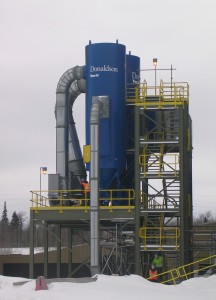
6,000 ft³ (170m³) of biomass suddenly sliding 60’ (18.3m) into a receiving hopper generates a considerable amount of dust. Few dumper installations try to control this dust, but it is an issue that is starting to receive attention from both health and environmental perspectives. It is possible to install an enclosure over the dumper pit and bridge, but it would require a fast-acting door on the drive-in side and a massive dust collector to keep the enclosure under a negative pressure to prevent fugitive dusting. The dust collector should also be connected to downstream conveyor transfer points.
Some installations have tried `fogging’ systems which lay down a blanket of fog to which dust particles attach to water particles. These are finicky systems and may work in warm climates, but are not appropriate for cold climates.
Chip Contamination by Dirt, Sand, Rocks, Snow and Ice
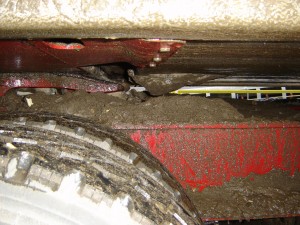
The outside and underside of the chip trucks can become contaminated by dirt, sand, rocks, snow and ice, as they travel along the roads and highways to the millsite. The contaminants often fall from the truck during the dumping process and end up being discharged into the wood chip furnish to the pulp mill. One study conducted showed an average of 200 kg (440 lbs) of snow, ice, dirt, sand and rocks falling off every chip truck at the truck dumper. The sand and rocks can cause considerable damage to downstream equipment in the pulpmill and biomass boiler, and should be prevented from entering the chip flow to the mill. Also, refer to the article titled “Removing Rock from Woody Biomass”, included elsewhere on this website.
Dumper Vendors
There are many companies that manufacture end-tippers. Recommended dumper vendors include:
Megatech Engineering, Surrey, BC, Canada http://www.megatech-engineering.com/
Bruks Rockwood http://www.bruks.com/products-by-name/truck-dumpers
Rader (Terrasource) http://terrasource.com/equipment/truck-dumpers-by-jeffrey-rader-brand/
Phelps Industries http://www.phelpsindustries.com/
The one side-tipper described in this article was manufactured by:
Tycrop Manufacturing, Rosedale, BC, Canada http://tycrop.com/
Copywrite © 8 February 2016
About the Author
Paul Janzé has more than 30 years experience in engineering design, project management, equipment manufacturing and maintenance, primarily in the forest products and energy industries. His industrial material handling experience includes: biomass handling and processing including forest residuals, logs, lumber, chips, pellets, woodwaste, corn stover, straw and poultry litter, sludge and biosolids; municipal solid waste (MSW); and coal and ash handling.
He has a keen interest in technologies which recover and utilize waste materials and convert them into products such as wood pellets. Paul’s specialties are fibre flow analysis and mass balances, process optimization and designing novel solutions to complex processing and handling problems.
Paul can be reached at: Advanced Biomass Consulting Inc., tel: 604-505-5857, email: pjanze@telus.net

Looking for a way to fully cube out a trailer with my peat and root substrate that is a daily waste product at my greenhouse. Any suggestions?
I’m looking for “used” truck dumpers. If you have access to this type of equipment or can refer me to someone, please let me know.